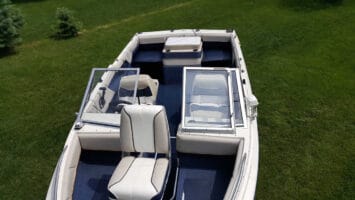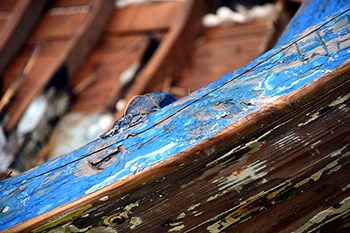I often get asked advice about rotted boat floors. Just because you have some rot on the floor of your boat, doesn’t necessarily mean you are doomed to a giant bill. There are many levels of severity, so let’s see how many boats we can put back into action.
The best way to know if your boat floor is too rotted to be worth fixing, is to know how much money or work is going to be needed. You’ll likely find a situation close to yours by reading this article. This will provide the answers you need.
Is The Rot Worth Your Time
People who are just getting their feet wet (pun intended) when they Begin Boating, often look at “low cost of entry” boats. Those boats most likely come with issues. 90% of the problems I find with boats comes from prior neglect. While we can’t do anything about the previous neglectful owner, we do have to deal with the repercussions.
I like to do my best to get a neglected boat back into the water. However I’ve gone way too far repairing a rotten boat floor once, and I still regret it. At the time I wasn’t aware of some of the products available to make the repairs much easier. It was a beautiful 22′ Sea Ray. It was yellow and white, my favorite color combo. The boat was neglected and had no title for the boat or trailer (not an easy fix).
I was able to bring back the upholstery and exterior, but the floor was really bad. Not only the floors were soft, but the stringers were badly rotted. I gutted the interior out and ripped out the entire deck. I cut out the stringers (they are like floor joists that support the boat floor) and remade them. Glassed everything back in and decked it. This took a couple months in very hot weather.
I made money on that boat (it was beautiful), but considering all the time and effort, I wouldn’t do it again. So the quick answer to the question of “Is Your Boat Floor Too Rotted To Be Worth Fixing?” is, IT DEPENDS. In other words there is no quick answer, so lets look at some scenarios.
So Let’s Use This Sea Ray For This Example
This boat was a 1990 and I paid $800 for it with no titles. It took $400 and lots of time and effort to get title in my name (You can check state by state boat title requirements here). So I had $1200 in it before starting any work. This Particular boat, if it was in really nice condition, would be a $6500 boat. It ran awesome and I knew I could clean up the hull and upholstery. I just had never repaired rotted floors before( at that time). Man did I get a lesson!
I made about $3K after selling it, but I wasn’t happy in the end. Though, bringing back a beautiful boat did mean something to me. So who might want to do a project like this?
- A person that has a sentimental attachment to the boat.
- It’s your dream boat and you finally got one you could afford.
- If you profit $7K or $8K to make it worth the hard work.
- Someone who feels this would be a great bonding and learning experience for them and their son.
- You have more time than money and a better boat isn’t in the budget.
- A person who uses Smith’s Original Clear Penetrating Epoxy Sealer [CPES] (I wish I did) (More on this later).
Different levels of Rot Require different Repairs
While the Sea Ray had been neglected for a long time and the boat’s floor rot was extensive, not every boat is going to be that bad. I’ve personally bought several boats with rotted floors since. Some were quick and easy repairs. A couple had stringers that started to rot on top. One was repaired without breaking the fiberglass skin. So how about a couple more example repairs that don’t break the bank or use up the whole summer doing the repair?
Sometimes It’s Simple
 I bought a 1997 Bayliner Fish and Ski that had a soft spot in the upper front deck of the bow where the fishing seat went. You could hear the rotten floor crackling when you stepped on it. Someone had tried to put a patch in another area near it, and they messed up the carpet, so it needed new carpet anyway.
I bought a 1997 Bayliner Fish and Ski that had a soft spot in the upper front deck of the bow where the fishing seat went. You could hear the rotten floor crackling when you stepped on it. Someone had tried to put a patch in another area near it, and they messed up the carpet, so it needed new carpet anyway.
I unmounted the seat holder, pealed off the carpet, and assessed the extent of the damage. I ended up removing the rotted deck and cutting a new piece to install. The support structure was pretty good, but I treated it with some CPES anyway. After coating the bottom and edges of the new piece of flooring with epoxy resin, I screwed it down into place.
Next, I used a 4 1/2 inch grinder with a sanding disk and sanded a slight indent along the cut lines. This creates a low spot for you to lay strips of fiberglass matting. Since it was a smaller area, I coated the entire board after building up the joints. Once it was cured, I glued a new piece of carpet over the repaired area, and reattached the seat mount.
So for just a couple hours of actual working on it, she was back to new. Well worth the effort, right?
Getting Down To The Start Of Stringer Rot
I had a 1996 Celebrity that had a 454 Mercruiser in really nice shape. The former owner only had the bow cover and had lost the rear cabin cover. He was using a tarp to keep the rain out. (It didn’t work!)
I ended up pulling the entire rotted floor out. I did this because there were too many places that needed repair. It would be more work to blend them all in together versus replacing it all. I removed all the seating and ski hold door and trim ring. I pulled the batteries and engine cover, then proceeded to remove the rotted boat floor. Always taking note of how the floor was pieced together. You want to install in the same pattern.
 This was another case where the tops of the stringers were starting to get rot. Again I treated the stringers with Smith’s Original Clear Penetrating Epoxy Sealer [CPES] where they were damaged. I was able to use the old floor pieces as a template for cutting out the new floor, being sure each one fit before moving on to the next.
This was another case where the tops of the stringers were starting to get rot. Again I treated the stringers with Smith’s Original Clear Penetrating Epoxy Sealer [CPES] where they were damaged. I was able to use the old floor pieces as a template for cutting out the new floor, being sure each one fit before moving on to the next.
After coating the floor pieces with epoxy resin and letting them cure, it was time to install the new floor. Grinding a gouge along all the joints was next. Then using epoxy resin to fill the joints along with strips of fiberglass matting, I built up the resin and matting until the floor was flush. With a bit of sanding to take out any high spots, it was time to glue in some new carpet and reinstall the boat interior. Then it was back to the lake.
Just The Floor Core Was Rotted On My Buddy’s Boat
My friend asked for help with a soft area in his boat floor. We took a look at it and used a small hammer to thud test to see how far the rot went. There is a distinct difference in sound when you hit a solid floor versus one that has very little substance because of wood rot. We took back the carpet carefully (it was in great condition). The top fiberglass layer was in great condition, but was delaminated from the wood core in the affected area.
So, what we did was drill a series of holes that were in a grid pattern at 5 inch spacing over the area. We had to be careful to only drill through the top layer of fiberglass and just into the wood core. You don’t want to go through the bottom layer of fiberglass, because your CPES will just drain out. The saw dust from drilling was dry so we didn’t need to do much more. We injected the CPES into the cavity, flooding it completely.
Then we laid a sheet of Polyethylene Plastic over the area (the resin won’t stick to it) plus a little overlap onto the good floor and weight it down. This will compress the floor down to level with the good section of flooring so everything cures to the correct level. You don’t need to worry about speed, because you have a lot of working time. You should probably wait a week before the next step because in this case, little air is getting into the wood section to help it cure. However we moved on after 5 days and it was rock solid.
Sand smooth if there are any bits sticking up, then apply carpet glue and relay the carpet. In my opinion, this is a better than new repair, because that section won’t rot again. By the way, this example was a section of floor that didn’t have any wood missing, but Let’s say you have a section of wood that after treatment with CPES, has gaps or depressions where ther is no wood. In this case you use Smith’s Epoxy Fill-it to fill the gap. Then once cured, sand smooth and you have a rock hard, rot free section of wood again.
What Are Your Rotten Circumstances
 There are more ways to make repairs to a rotted boat floor, but it really does depend on what your goal is with the boat. Are you planning on keeping the boat for the rest of your life, or just making it last for a few more seasons.
There are more ways to make repairs to a rotted boat floor, but it really does depend on what your goal is with the boat. Are you planning on keeping the boat for the rest of your life, or just making it last for a few more seasons.
Lets say you have a 1994 19′ Bayliner Capri Bowrider. It’s a bit rough around the edges and just hasn’t been maintained well at all. However, you bought it because it was an inexpensive way to get out on the water. You love to fish and occasionally pull the grandkids around the lake on a tube.
This boat has very little potential to ever be a perfect boat. It will never reach a high enough value to make you want to go through the trouble of a nice floor restoration. Right now it is just too squishy for comfort.
In this case, you should just tear out the carpet and sweep the floor clean. Grab some sheets of green treat plywood from the Home Depot. Apply some Liquid Nails type of adhesive and screw it down to the old floor. Glue some new indoor/outdoor carpet down and enjoy your boat. If you are thinking this won’t last, then read on.
Your New Floor Will Last
I built my kids a play yard 24 years ago. I used 1/2″ green treat plywood for the 3 decks that are on it. Today I can jump up and down on those decks with no fear. Those decks never had a day of being under a cover or being stored in a garage, so don’t let anyone try and tell you that your floor won’t last.
If you just want to firm up your boat floor on the cheap, this is a good way to go. After-all, it’s your boat and your decision. This will give you a few years to save up for a better boat anyway.
No matter what, don’t stress about a rotten boat floor. Just fix it in a way that meets your goal, and get back on the water!

